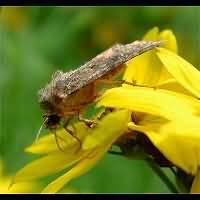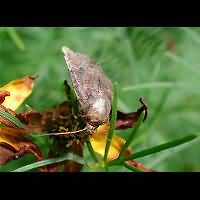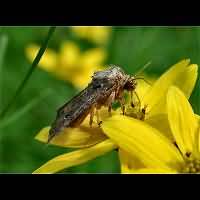Common Rustic Mesapamea secalis
Attention, please! In Central and Western Europe, including Britain, the genus Mesapamea is comprised of two, extremely similar species. They are the Common Rustic and the Lesser Common Rustic. With a few small exceptions these species have to be examined under the microscope in order to be able to tell which is which with certainty. Microscopical examination did not take place here. Because of size, behavior, colouring and the fact the Common Rustic is the common species in this part of the country, it is assumed this is the Common Rustic, but it is not a foregone conclusion.
The Common Rustic is an extremely small Owlet Moth. It is very variable too and being brownish or purplish red it is extremely similar to other small moths. It is especially similar to Endotricha flammealis, a Pyralid Moth. And the two species share another peculiar hobby: both are seen feeding during daytime quite often. The two Rustics stand apart from all the other minute Owlet Moths by the rounded tip of the wings. In all other species the tip is more pointed. The wingspan of the Common Rustic usually is between 29 and 36mm. The Lesser Common Rustic is slightly smaller, but there is a lot of overlap.
The eggs, which have been laid in summer, hatch in September. The caterpillar lives inside the stem of the foodplant. It is seldom seen. If you want to see it, try at night when the caterpillar does sometimes go from one hostplant to another. The caterpillar also overwinters within the stem of a plant. After overwintering it will spin a loose cocoon near or just below the ground. Pupation takes about a month. The caterpillar is light green with pinkish or purplish markings on the side. These may be vague, or even absent. The head is lightbrown. The larva grows to a length of 22 to 26mm. The foodplants known are grasses, especially Cock's Foot, Tall Fescue and Tufted Hair-grass. The Common Rustic sometimes is a pest in cereal crops.
Even though the Common Rustic is single-brooded it is on the wing for a long time. It flies about from mid-May to mid-September. Regularly visits flowers, including those in gardens, in broad daylight. When it is visiting flowers it behaves peacefully and is an easy going photographer's model. Is attracted to both light and sugar. Animals caught then are very difficult to photograph, for they are extremely impatient. A common and widespread species all over the British Isles, except for the hills and highlands of Scotland, where it is absent. Very common on the continent as well.
Attention, please! In Central and Western Europe, including Britain, the genus Mesapamea is comprised of two, extremely similar species. They are the Common Rustic and the Lesser Common Rustic. With a few small exceptions these species have to be examined under the microscope in order to be able to tell which is which with certainty. Microscopical examination did not take place here. Because of size, behavior, colouring and the fact the Common Rustic is the common species in this part of the country, it is assumed this is the Common Rustic, but it is not a foregone conclusion.
The Common Rustic is an extremely small Owlet Moth. It is very variable too and being brownish or purplish red it is extremely similar to other small moths. It is especially similar to Endotricha flammealis, a Pyralid Moth. And the two species share another peculiar hobby: both are seen feeding during daytime quite often. The two Rustics stand apart from all the other minute Owlet Moths by the rounded tip of the wings. In all other species the tip is more pointed. The wingspan of the Common Rustic usually is between 29 and 36mm. The Lesser Common Rustic is slightly smaller, but there is a lot of overlap.
The eggs, which have been laid in summer, hatch in September. The caterpillar lives inside the stem of the foodplant. It is seldom seen. If you want to see it, try at night when the caterpillar does sometimes go from one hostplant to another. The caterpillar also overwinters within the stem of a plant. After overwintering it will spin a loose cocoon near or just below the ground. Pupation takes about a month. The caterpillar is light green with pinkish or purplish markings on the side. These may be vague, or even absent. The head is lightbrown. The larva grows to a length of 22 to 26mm. The foodplants known are grasses, especially Cock's Foot, Tall Fescue and Tufted Hair-grass. The Common Rustic sometimes is a pest in cereal crops.
Even though the Common Rustic is single-brooded it is on the wing for a long time. It flies about from mid-May to mid-September. Regularly visits flowers, including those in gardens, in broad daylight. When it is visiting flowers it behaves peacefully and is an easy going photographer's model. Is attracted to both light and sugar. Animals caught then are very difficult to photograph, for they are extremely impatient. A common and widespread species all over the British Isles, except for the hills and highlands of Scotland, where it is absent. Very common on the continent as well.







